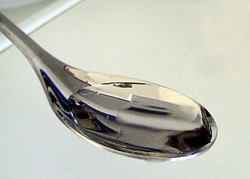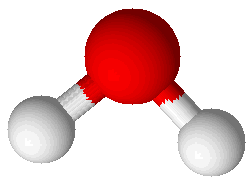
A tablespoon of water

A molecule of water
The following paragraphs are meant to summarize the activity you did in class. Compare this summary to the one your teacher asked you to write. For homework use your comparison to write down all changes you would need to make to your summary to make it accurate and complete. If you notice something that this summary leaves out then please bring it to the attention of your teacher.
In this activity we learned about the chemical unit called the mole. The mole is the number of atoms which has a mass in grams equal to the numerical value of the mass of the atom in atomic mass units (amu). So the mass of an average carbon atom is 12 amu and the mass of a mole of carbon atoms is 12 g. The activity began with a set of data that showed when there are equal numbers of quail eggs and chicken eggs the ratio by mass is 1:16. That is, each chicken egg weighs sixteen times one quail egg. Therefore 10 chicken eggs weighs sixteen times 10 quail eggs. This can be extended to any number so that for an equal number of each type of egg the mass of chicken eggs is sixteen times the mass of quail eggs.
This ratio by mass means that without knowing how many eggs there are it is possible to say whether the number of eggs is equal. For example, 32 kg of chicken eggs has the same number of eggs as 2 kg of quail eggs. Similarly, 32 lbs of chicken eggs has the same number of eggs as 2 lbs of quail eggs.
In the next part of the activity these ideas were extended to atoms. Atoms of oxygen and sulfur were compared with each other. Oxygen atoms have a mass (on average) of 16.00 amu each. Sulfur atoms have an average mass of 32.00 amu, which is twice the mass of an oxygen atom. This will be true no matter how many atoms there are. If there are a hundred oxygen atoms and a hundred sulfur atoms then the number of atoms is equal but the mass of all 100 sulfur atoms will be twice the mass of the 100 oxygen atoms. This idea can be turned around and stated another way: when the mass of a sample of sulfur atoms is twice the mass of a sample of oxygen atoms then there are the same number of sulfur atoms as oxygen atoms in the two samples. This means that, the ratio of two samples’ masses will equal the ratio of the atoms’ masses when there are the same number of atoms in both samples. For example, 16 lbs of oxygen has the same number of oxygen atoms as the number of sulfur atoms in 32 lbs of sulfur.
 A tablespoon of water |
 A molecule of water |
The important message here is that it is possible to use a ratio of the masses of the elements to count atoms. Or maybe not count atoms but at least it is possible to tell whether the number of atoms is the same or different. Actually counting atoms means using the mole. The mole is equal to 6.022 × 1023. It is the number of atoms needed to have a mass in grams equal to the atomic mass of an element. It can also be used for molecules, like water.
A single molecule of water has a mass of 18.02 amu. This is because the hydrogen atoms each have a mass of 1.01 amu and the oxygen atom has a mass of 16.00 amu (H2O: 2 × 1.01 amu + 1 × 16.00 amu = 18.02 amu). A mole of water molecules has a mass of 18.02 g. A mole of water molecules is 6.022 × 1023 molecules so 18.02 grams of water has far more molecules than 18.02 amu, which is the mass of just one molecule. A single molecule is too small to see but 18.02 grams of water is a just a bit more than a tablespoon-full.
This mass in grams that has a mole of atoms or molecules is called the molar mass, which is always given in units of grams per mole (g/mol). The molar mass for any chemical formula may be found just by adding up the masses of the atoms in the formula. Iron(II) sulfate (FeSO4) has a molar mass of 151.9 g/mol because Fe = 55.85 g/mol, S = 32.00 g/mol, and O = 16.00 g/mol (55.845 + 32.00 + 4 × 16.00 = 151.9).
When using the mole to count atoms it is important to take the structure of the molecules into account. For example, one mole of fluorine gas (F2) has a mass of 38.00 grams. There are 6.022 × 1023 molecules of F2 in 38.00 grams of fluorine gas. There are twice that many atoms of fluorine in 38.00 grams of the gas. This is because there are two atoms per molecule. Here is how the calculation could be written out:
2 atoms 6.02 × 1023
1 mol F2 molecules × ---------- × ---------- = 1.204 × 1024 atoms of F2
1 molecule 1 mol
On the back you will find some examples of calculations that are usually done using mass, moles, and numbers of atoms or molecules:
The molar mass of a chemical substance is the molecular weight of the substance expressed in units of grams per mole (g/mol). It is calculated by adding up the atomic masses of all the atoms in the molecular formula of the substance. Here are two examples:
Molar Mass of H2 (elemental hydrogen)
From the periodic table: H atoms have an atomic mass of 1.00794 g/mol
2 × 1.00794 g/mol = 2.01559 g/mol 2.01559 g
The molar mass of H2 is ----------
1 mol
Molar Mass of Fe2O3 (iron(III) oxide, aka rust)
Fe: 55.845 g/mol and O: 15.9994 g/mol
2 × 55.845 g/mol + 3 × 15.9994 g/mol = 159.69 g/mol 159.69 g
The molar mass of Fe2O3 is ----------
1 mol
Since atoms and molecules are far to small to see, much less count, scientists count them by weighing them. This is the value of the molar mass. If you know the molar mass of a substance then you can calculate the number of moles or the mass of that substance.
Finding Mass from Moles: What is the mass of 2.00 moles of H2?
2.01559 g
2.00 mol H2 × ---------- = 4.03 g H2
1 mol
Finding Moles from Mass: How many moles are in 399.22 g Fe2O3?
1 mol
399.22 g Fe2O3 × ---------- = 2.5000 mol Fe2O3
159.69 g
It is important to remember that for the purpose of studying chemistry the important quantity is the number of moles, not the mass. It is the number of molecules reacting with each other that predicts the outcome, not the mass. For that reason it is valuable to have an understanding of relative numbers of particles.
Which sample has a larger number of particles (that is, number of moles):
8.06 g H2 or 79.85 g Fe2O3?
1 mol
8.06 g H2 × ---------- = 4.00 mol H2
2.01559 g
1 mol
79.85 g Fe2O3 × ---------- = 0.5000 mol Fe2O3
159.69 g
Don't be surprised by the fact that there are 8 times more particles of
H2 than there are particles of Fe2O3!
It is instructive to take note of just how many particles there are in a mole because it gives you an appreciation for the incredibly tiny size of the molecular world. To accomplish the purpose of giving you this appreciation you will calculate the number of particles there are in various samples. This is done by using the definition of the mole: there are 6.02 × 1023 objects in a mole. Mathematically the number is expressed with the unit mol in the denominator: 6.02 × 1023/1 mol.
Finding Number of Particles from Mass
1 mol 6.02 × 1023
399.22 g Fe2O3 × ---------- × ---------- = 1.505 × 1024 particles of Fe2O3
159.69 g 1 mol
Number of particles can be calculated starting with moles, too. Just
leave off the molar mass conversion ratio.